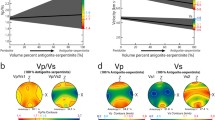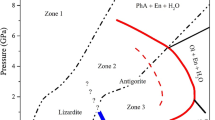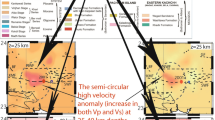Abstract
Serpentinization is an important phenomenon for understanding the water cycle and geodynamics of subduction zones in the upper mantle. In this study, we evaluate quantitatively the degree of serpentinization using the seismic velocity. The results show that serpentinization mainly occurs in the forearc mantle wedge along the subducted oceanic crust, and the degree of serpentinization in the forearc mantle wedge of Kyushu is strongly heterogeneous and varies from 0 to 12 %, containing about 0–1.8 % water contents. In general, the degree of serpentinization gradually decreases with depth from 40 to 80 km and the largest degree usually occur in about 40–50 km depth. Localized high anomalies of serpentinization are revealed in the northern and southern portions of Kyushu, respectively. We suggest that in the northern portion of the forearc mantle wedge, the water contents are relatively large, which might result from the abundant fractures and cracks with more fluids in the subducting slab because of the subduction of Kyushu-Palau ridge and the sudden change in its subduction angle of Philippine Sea lithosphere. But the high degree of serpentinization in the southern portion is closely associated with the active left-lateral shear zone revealed by global positioning system site velocities and earthquake focal mechanisms. In addition, the present results also display that the low degree of serpentinization in the central domain of the forearc mantle wedge is consistent with the location of anomalous arc volcano. The distribution of water contents is closely associated with the degree of serpentinization in the forearc mantle wedge.








Similar content being viewed by others
References
Abe Y, Ohkura T, Hirahara K, Shibutani T (2011) Water transportation through the Philippine Sea slab subducting beneath the central Kyushu region, Japan, as derived from receiver function analyses. Geophys Res Lett 38:L23305. doi:10.1029/2011GL049688
Bostock MG, Hyndman RD, Rondenay S, Peacock SM (2002) An inverted continental Moho and serpentinization of the forearc mantle. Nature 417:536–538
Carlson RL, Miller DJ (1997) A new assessment of the abundance of serpentinite in the oceanic crust. Geophys Res Lett 24:457–460
Carlson R, Miller D (2003) Mantle wedge water contents estimated from seismic velocities in partially serpentinized peridotites. Geophys Res Lett 30(5):1250. doi:10.1029/2002GL016600
Christensen N (1966) Elasticity of ultrabasic rocks. J Geophys Res 71:5921–5931
Christensen N (1978) Ophiolites, seismic velocities and oceanic crustal structure. Tectonophysics 47:131–157
Christensen N (1996) Poisson's ratio and crustal seismology. J Geophys Res 101:3139–3156
Christensen N (2004) Serpentinites, peridotites, and seismology. Int Geol Rev 46:795–816
DeMets C, Gordon RG, Argus DF (2010) Geologically current plate motions. Geophys J Int. 181:1–80
Hacker BR, Peacock SM, Abers GA, Holloway SD (2003) Subduction factory-2. Are intermediate-depth earthquakes in subducting slabs linked to metamorphic dehydration reactions? J Geophys Res 108:2030
Hilairet N, Reynard B (2009) Stability and dynamics of serpentinite layer in subduction zone. Tectonophysics 465:24–29
Hilde TWC, Lee CS (1984) Origin and evolution of the west Philippine basin: a new interpretation. Tectonophysics 102:85–104
Horen H, Zamora M, Dubuisson G (1996) Seismic waves velocities and anisotropy in serpentinized peridotites from **gaze ophiolite: abundance of serpentine in slow spreading ridge. Geophys Res Lett 23:9–12
Hyndman R, Peacock S (2003) Serpentinization of the forearc mantle. Earth Planet Sci Lett 212:417–432
Kamata H, Kodama K (1994) Tectonics of an arc–arc junction: an example from Kyushu Island at the junction of the Southwest Japan Arc and the Ryukyu Arc. Tectonophysics 233:69–81
Kamata H, Kodama K (1999) Volcanic history and tectonics of the Southwest Japan Arc. Isl Arc 8:393–403
Kamiya S, Kobayashi Y (2000) Seismological evidence for the existence of serpentinized wedge mantle. Geophys Res Lett 27:819–822
Kawano S, Katayama I, Okazaki K (2011) Permeability anisotropy of serpentinite and fluid pathways in a subduction zone. Geology 39:939–942
Kodama K, Nakayama K (1993) Paleomagnetic evidence for post-late Miocene intra-arc rotation of south Kyushu, Japan. Tectonics 12:35–47
Lefeldt M, Ranero CR, Grevemeyer I (2012) Seismic evidence of tectonic control on the depth of water influx into incoming oceanic plates at subduction trenches. Geochem Geophys Geosyst 13:Q05013
Mahony SH, Wallace LM, Miyoshi M, Villamor P, Sparks RSJ, Hasenaka T (2011) Volcano-tectonic interactions during rapid plate-boundary evolution in the Kyushu region, SW Japan. The Geological Society of America 123:2201–2223
Miller DJ, Christensen NI (1997) Seismic velocities of lower crustal and upper mantle rocks from the slow-spreading Mid-Atlantic Ridge, south of the Kane Fracture Zone (MARK). Proc Ocean Drill Program Sci Results 153:437–454
Nishimura S, Hashimoto M (2006) A model with rigid rotations and slip deficits for the GPS-derived velocity field in southwest Japan. Tectonophysics 421:187–207
Okamura Y, Watanabe M, Morijiri R, Satoh M (1995) Rifting and basin inversion in the eastern margin of the Japan Sea. Island Arc 4:166–181
Ohkura T (2000) Structure of the upper part of the Philippine Sea plate estimated by later phases of upper mantle earthquakes in and around Shikoku, Japan. Tectonophysics 321:17–36
Ohtani E, Litasov K, Hosoya T, Kubo T, Kondo T (2004) Water transport into the deep mantle and formation of a hydrous transition zone. Phys Earth Planet Inter 143:255–269
Okino K, Shimakawa Y, Nagaoka S (1994) Evolution of the Shikoku Basin. J Geomagn Geoelectr 46:463–479
Peacock S (1993) Large-scale hydration of the lithosphere above subducting slabs. Chem Geol 108:49–59
Petit C, Fournier M (2005) Present-day velocity and stress fields of the Amurian Plate from thin-shell finite element modelling. Geophys J Int 160(1):357–369
Reynard B (2013) Serpentine in active subduction zones. Lithos 178:171–185
Sallares V, Loriente S, Prada M, Gracia E, Ranero C, Gutscher M, Bartolome R, Gailler A, Danobeitia J, Zitellini N (2013) Seismic evidence of exhumed mantle rock basement at the Gorringe Bank and the adjacent Horseshoe and Tagus abyssal plains (SW Iberia). Earth Planet Sci Lett 365:120–131
Schmidt MW, Poli S (1998) Experimentally based water budgets for dehydrating slabs and consequences for arc magma generation. Earth Planet Sci Lett 163:361–379
Schwartz S, Allemand P, Guillot S (2001) Numerical model of the effect of serpentinites on the exhumation of eclogitic rocks: insights from the Monviso ophiolitic massif (Western Alps). Tectonophysics 342:193–206
Seno T, Stein S, Gripp AE (1993) A model for the motion of the Philippine Sea Plate consistent with NUVEL-1 and geological data. J Geophys Res 101:11305–11315
Tada T (1985) Spreading of the Okinawa Trough and its relation to the crustal deformation in Kyushu. J Seismol Soc Japan 38:1–12
Tahara M, Uehira K, Shimizu H et al (2008) Seismic velocity structure around the Hyuganada region, Southwest Japan, derived from seismic tomography using land and OBS data and its implications for interplate coupling and vertical crustal uplift. Phys Earth Planet Inter 167:19–33
Uehira K, Shimizu H, Matsuwo N, Goto K (2001) The detailed structure of the deep seismic zone and focal mechanism solutions in and around the Kyushu district, Japan. Earth Mon 23:669–673
Ulmer P, Trommsdorff V (1995) Serpentine stability to mantle depths and subduction-related magmatism. Science 268:858–861
Wada I, Wang KL, He JG, Hyndman RD (2008) Weakening of the subduction interface and its effects on surface heat flow, slab dehydration, and mantle wedge serpentinization. J Geophys Res 113
Wallace L, Ellis S, Miyao K, Miura S, Beavan J, Goto J (2009) Enigmatic, highly active left-lateral shear zone in southwest Japan explained by aseismic ridge collision. Geology 37:143–146
Wang Z, Zhao D (2006) Vp and Vs tomography of Kyushu, Japan: new insight into arc magmatism and forearc seismotectonics. Phys Earth Planet Inter 157:269–285
**a S, Zhao D, Qiu X (2008) Tomographic evidence for the subducting oceanic crust and forearc mantle serpentinization under Kyushu, Japan. Tectonophysics 449:85–96
Yamaji A (2003) Slab rollback suggested by latest Miocene to Pliocene forearc stress and migration of volcanic front in southern Kyushu, northern Ryukyu Arc. Tectonophysics 364:9–24
Zhao D (2012) Tomography and dynamics of western-Pacific subduction zones. Monogr Environ Earth Planets 1(1):1–70
Zhao D, Mishra O, Sanda R (2002) Influence of fluids and magma on earthquakes: seismological evidence. Phys Earth Planet Inter 132:249–267
Acknowledgments
This work was partially supported by grants from the National Natural Science Foundation of China (Grant Nos. 41222039, 91328206, 91128209). We thank the data centers of Hi-net seismic networks for providing the data used in this study. The figures in this paper were produced using Generic Map** Tools (GMT) software written by Wessel and Smith. Guest editor Dr. Guoliang Zhang and two anonymous referees provided very thoughtful review comments and suggestions that have improved this paper.
Author information
Authors and Affiliations
Corresponding author
Rights and permissions
About this article
Cite this article
**a, S., Sun, J. & Huang, H. Degree of serpentinization in the forearc mantle wedge of Kyushu subduction zone: quantitative evaluations from seismic velocity. Mar Geophys Res 36, 101–112 (2015). https://doi.org/10.1007/s11001-014-9239-3
Received:
Accepted:
Published:
Issue Date:
DOI: https://doi.org/10.1007/s11001-014-9239-3




